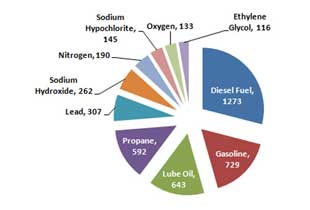Hazardous Substance Reporting Requirements:
 The
purpose of requiring facilities to report hazardous materials that they generate, store and transport is to ensure proper response
measures and equipment are readily available in the event of an emergency. Accidents involving chemicals or radioactive materials
represent a significant threat to the environment, public health and safety, and community well-being. Without proper response measures
and equipment there is a risk of injury, exposure, or death to both the responders and the public.
The
purpose of requiring facilities to report hazardous materials that they generate, store and transport is to ensure proper response
measures and equipment are readily available in the event of an emergency. Accidents involving chemicals or radioactive materials
represent a significant threat to the environment, public health and safety, and community well-being. Without proper response measures
and equipment there is a risk of injury, exposure, or death to both the responders and the public.State Emergency Response Commissions (SERC) oversee the implementation of reporting requirements in each state.
Local Emergency Planning Committees (LEPC) work to understand chemical hazards in the community, develop emergency plans in case of an accidental release, and look for ways to prevent chemical accidents. LEPCs are made up of emergency management agencies, responders, industry and the public.
EPA's Toxics Release Inventory (TRI) is a database containing data on disposal or other releases of over 650 toxic chemicals from thousands of US facilities and information about how facilities manage those chemicals through recycling, energy recovery, and treatment. One of TRI's primary purposes is to inform communities about toxic chemical releases to the environment.
The Emergency Planning and Community Right-to-Know Act (EPCRA), also known as the EPA Superfund Amendments and Reauthorization Act (SARA) Title III, is intended to inform government agencies, local fire departments, and the public of hazardous materials storage within their community.
OSHA Hazard Communication Standard (HCS), also known as the Workers Right-to-Know Act requires employers to inform their employees of the chemical hazard that they may be exposed to in the workplace. The format required for chemical hazards in the workplace is the Material Safety Data Sheet (MSDS).
Any person who stores, transports on-site, dispenses, uses or handles hazardous materials in excess of the amount listed in the International Fire Code, 2006 Edition, Chapter 1 and Chapter 27 is required to report chemicals and obtain a SFM hazardous materials permit.
Any facility required by U.S. Occupational Safety and Health Administration (OSHA) regulations to prepare or maintain a Material Safety Data Sheet (MSDS), including those who store extremely hazardous substances EPA List of Lists is required to report those chemicals.
Contaminants of Concern:
Hazardous substances may be explosive, flammable, combustible, corrosive, reactive, poisonous, biological or radioactive, as well as solid, liquid or gaseous. Hazardous substances are covered in depth by numerous websites and databases that are described at Research Individual Chemicals.Implementing Solutions:
Please submit your experiences (successes/challenges) and tribal-specific documents to share on our website using the attached form.Download Form
Resources:
Bienniel Hazardous Waste Report Frequently Asked Questions [pdf]Rock Springs Fire Department: Identifying Requirements for Reporting Hazardous Materials Storage to Local Fire Departments [pdf]
Wisconsin Hazardous Substance Spills Reporting Requirements 4-page factsheet [pdf]
Oregon Community Right to Know and Protection Act Hazardous Information Survey [pdf]
Websites:
When are you required to report an Oil Spill and Hazardous Substance Release?:www.epa.gov/emergency-response/when-are-you-required-report-oil-spill-and-hazardous-substance-release
The National Response Center's primary function is to serve as the national point of contact for reporting all oil, chemical, radiological, biological, and etiological discharges into the environment anywhere in the United States and its territories:
www.nrc.uscg.mil/ContactUs.aspx#
EPA's Facility Response Plan (FRP) Overview (Rule Summary, Rule History, Additional Information):
www.epa.gov/oil-spills-prevention-and-preparedness-regulations/facility-response-plan-frp-overview
EPA's Overview of the Spill Prevention, Control, and Countermeasure (SPCC) Regulation:
www.epa.gov/oil-spills-prevention-and-preparedness-regulations/overview-spill-prevention-control-and
EPCRA Requirements:
swww.epa.gov/epcra
Hazardous Waste State Resource Locator Use the pulldown or the sensitive map to find hazardous waste and RCRA compliance resources on state websites. You will find general information, fact sheets, permit forms and guidance, contact information and other helpful resources and tools. See also a description of Federal rules.
www.envcap.org/statetools/hzrl/hazmanaging.cfm
AristaTek Newsletters provide interesting articles on hazardous substances:
www.aristatek.com/Newsletter/archive.aspx
Related Pages:
Coal MiningEmergency Planning, Management, and Response
Hazardous Waste and Emergency Response Training Requirements
Oil Spill Prevention
Oil Spill Response
RCRA
For more information, please contact:
Jennifer Williams, Alaska Program Coordinator, Sr.
Tel: 928/523-0673
Email: Jennifer.Williams@nau.edu
Tel: 928/523-0673
Email: Jennifer.Williams@nau.edu
Last updated: July 10, 2015
